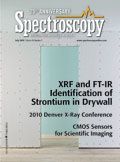Atomic Absorption: Feeding the Food Safety Market
While viewed as a mature technology, atomic absorption is still an attractive choice, particularly in the area of food safety.

Some metallic elements are essential to the health and well being of the human body as they play an important role in basic functions. Examples of these include phosphorus, which is needed for muscle and tissue growth, and calcium, which is critical for normal cell operation. Minute amounts of zinc and manganese are required for hormone production and enzyme function. The absence or excess of these elements in the diet would result in the body not functioning in a normal and healthy way. Other elements such as arsenic, mercury, and lead are toxic and offer no physiological benefit. Entry of these elements into the body is usually via ingestion of food that has been contaminated due to pollution of the environment where the food is produced. Food and beverage suppliers and manufacturers, therefore, have a responsibility to know what is in the food they are supplying to consumers.

Hazel Dickson
Food Safety and the Media
Recent years have seen a change in the availability of research and information relating to food and public health. Such research is no longer only visible to scientific researchers through academic literature but is becoming more and more visible to the general public through news websites, magazine articles, and online blogs and social networking sites — for example, the U.S. Food and Drug Administration now announces product recalls though the real-time information network Twitter. In addition, the past several months have seen a wealth of articles appearing in the general public news relating specifically to trace elements in foodstuffs, including antimony and arsenic in fruit juice, lead in cocoa products, and tin in canned foods. With an ever-increasing public and consumer awareness, the demands placed on food analysis and testing laboratories has reached an all-time high.
Regulations and Guidelines
Global legislation exists to protect consumer health by controlling contaminants and toxins in foodstuffs. To aid and elaborate food safety legislation, the CODEX Alimentarius was established by the Food and Agriculture Organisation (FAO) of the United Nations and World Health Organisation (WHO) in 1963 and provides internationally recognized standards, guidelines, and codes of practice. The elements to which the greatest number of standards and controls are applied are arsenic, cadmium, lead, mercury, and tin. The maximum levels of toxic elements in foodstuffs is typically set around 0.1 mg/kg, but this can vary depending upon country or region, food type, and typical consumption (1).

Figure 1: Food analysis continues to be an important application of AA spectroscopy.
Regulations and guidelines on labeling and nutritional content also cover a variety of trace elements. When a nutrient declaration is applied, foodstuffs that provide more than 5% of the nutrient reference value (recommended daily allowance) per 100 g are usually stated (2). Nutritional elements include calcium, magnesium, iron, zinc, iodine, copper, and selenium. Fortified products such as iron-enriched cereals and calcium-enriched yogurts and dairy drinks must also quantify fortification claims on the label. Labeling of sodium on foodstuffs is usually included as an element listed in the main nutritional information. Sodium comes from not only sodium chloride but also many other additives and preservatives, particularly in foods requiring water reconstitution, including monosodium glutamate, sodium saccharin, and sodium bicarbonate — baking soda. In fact, over 75% of sodium consumed in a typical diet comes from manufactured and processed foods, rather than the salt added during cooking or at the dinner table (3).
A Key Player in Food Safety
The prominence of food safety in the global analytical community has revealed atomic absorption (AA) as a key player in the analysis of trace elements in foodstuffs. An established technique of several decades, AA is proving to be the technique of choice for those laboratories requiring dedicated analysis on a regular basis. Analytical laboratories inherently demand robust and reliable methodologies and instrumentation. AA offers an ideal solution, providing excellent sensitivity, accuracy, and precision. In addition, advances in automation, through online sample dilution and automated standard preparation, simplify routine tasks and offer increased productivity and sample throughput.
One of the fastest growing markets in food safety is China, mirrored by the continued growth of the Chinese Gross Domestic Product (GDP). The Food Safety Law, introduced in China in June 2009, which toughens penalties against manufacturers of mislabeled or tainted food, and has raised the profile of food safety in this region significantly. This has resulted in a noticeable increase in the trace elemental analysis of foodstuffs. China is the world's largest exporter of fruits and vegetables, with meat, fish, and cereals (such as rice) contributing significantly to the billion-dollar export market.
Feeding the Food Safety Market
AA is being used around the globe to ensure laboratories meet the requirements for the analysis of trace elements in foodstuffs. As mentioned, the analysis of sodium in food is of great importance, with some laboratories analyzing over 100 samples per day. Flame AA offers a simple, dedicated solution and, with the use of an intelligent on-line dilution system and autosampler, provides complete automation over several orders of magnitude. Flame and furnace systems also can be used as complementary techniques for the analysis of multiple elements in the same sample. The global annual production of rice, the staple food of most Asian countries, is approximately 600 million tons. Flame AA can be used to analyze the essential elements in rice, such as manganese and zinc, while furnace AA can be used to ensure toxic elements such as cadmium and lead are below legislative limits (4). A major benefit of furnace AA is the small sample volume required for analysis. Typically, only a few microliters of sample are needed, allowing minimal dilution on the original sample to achieve the very best detection limits.
The unique elemental properties of mercury can make it a difficult element to analyze by standard flame and furnace methods. However, by using a continuous flow system with online mercury reduction and cold vapor generation, detection limits in the parts per billion range can be achieved (5). This is comparable to the detection limits achieved with inductively coupled plasma–optical emission spectroscopy (ICP-OES), yet is a simple and economical solution, making it accessible for laboratories worldwide. The method has been used for the analysis of mercury in fish, which is yet another prominent global issue relating to trace elements in foodstuffs. Minamata Bay, located in the Kumamoto Prefecture, Japan, saw over 10,000 individual cases of mercury poisoning, following disposal of mercury-contaminated wastewater into the local river, however, it took several years before the effects were observed and the source of the contamination identified. Bioaccumulation of mercury in the marine food chain results in high levels in predatory fish (such as tuna), which can result in mercury poisoning in humans if such fish is consumed regularly.
Looking Forward
The use of atomic absorption in the trace elemental food laboratory is likely to continue into the future, even as legislative requirements tighten and lower detection limits are demanded. Flame, furnace, and vapor techniques, in combination with preparative accessories and automation provide versatile, robust, and reliable configurations for even the most challenging of applications. For those laboratories employing more than one trace elemental analysis technique, such as ICP-OES and ICP-mass spectrometry (MS), AA still maintains a significant presence and is used for dedicated applications like sodium or mercury, as a screening tool for unknown samples, or as a ready-to-go walk-up system for the analysis of single or urgent samples.
Atomic absorption is expected to maintain a strong presence within food analysis laboratories, particularly within this tough economic climate. With reliable and robust technology, yet simple and affordable operation, atomic absorption will continue to feed the food safety market for years to come.
Hazel Dickson currently works as the AA Applications Chemist for Thermo Fisher Scientific in Cambridge, UK, with a particular interest in food safety. Hazel holds a first class degree in Chemistry with Study in Industry, obtained from the University of Sheffield, UK. She spent a placement year of her degree working as an analytical chemist at GlaxoSmithKline, using MS for the structural characterization of pharmaceutical compounds. She has also just finalized a PhD, focusing on the use of laser-based MS methods for the analysis of small molecules and elements in biological samples.
References
(2) www.food.gov.uk/foodlabelling/
(3) www.food.gov.uk/healthiereating/salt/
(4) Application Note, "Determination of trace elements in rice products by flame and graphite furnace AA," Thermo Fisher Scientific.
(5) Application Note, "Accurate analysis of low levels of mercury in fish by vapor generation AA," Thermo Fisher Scientific.

Applications of Micro X-Ray Fluorescence Spectroscopy in Food and Agricultural Products
January 25th 2025In recent years, advances in X-ray optics and detectors have enabled the commercialization of laboratory μXRF spectrometers with spot sizes of ~3 to 30 μm that are suitable for routine imaging of element localization, which was previously only available with scanning electron microscopy (SEM-EDS). This new technique opens a variety of new μXRF applications in the food and agricultural sciences, which have the potential to provide researchers with valuable data that can enhance food safety, improve product consistency, and refine our understanding of the mechanisms of elemental uptake and homeostasis in agricultural crops. This month’s column takes a more detailed look at some of those application areas.